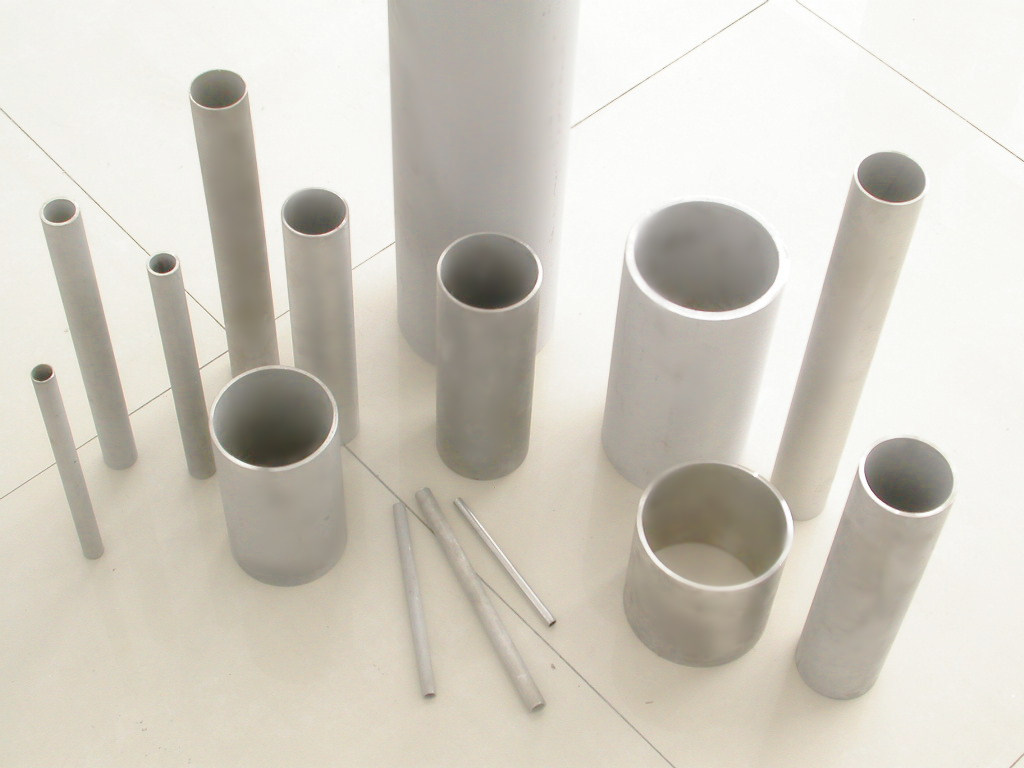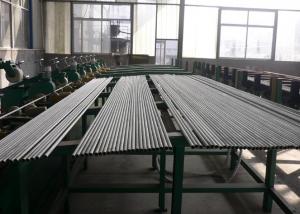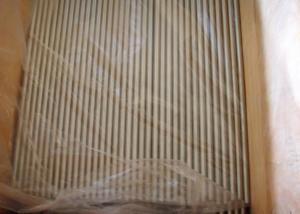1.4301 Stainless Steel Seamless Pipe
- Loading Port:
- China Main Port
- Payment Terms:
- TT or LC
- Min Order Qty:
- 5 Tons m.t.
- Supply Capability:
- 1000 Tons Per Month m.t./month
OKorder Service Pledge
OKorder Financial Service
You Might Also Like
Stainless Steel Seamless Pipe
APPLICATION:
Construction industry.
Chemical industry
Water tube
Pulp&Paper making industry
Heat exchanger tube,boiler tube,condenser tube,etc.
Available size range of Stainless Steel Seamless Pipe
|
OUTSIDE DIAMETER |
WALL THICKNESS | ||||||||
|
INCH |
MM |
Sch10 |
Sch40 |
STD |
Sch80 |
XS |
Sch160 |
XXS | |
|
1/8" |
10.29 |
1.24 |
1.73 |
1.73 |
2.41 |
2.41 |
- |
- | |
|
1/4" |
13.72 |
1.65 |
2.24 |
2.24 |
3.02 |
3.02 |
- |
- | |
|
3/8” |
17.15 |
1.65 |
2.31 |
2.31 |
3.20 |
3.20 |
- |
- | |
|
1/2" |
21.34 |
2.11 |
2.77 |
2.77 |
3.73 |
3.73 |
4.78 |
7.47 | |
|
3/4 " |
26.67 |
2.11 |
2.87 |
2.87 |
3.91 |
3.91 |
5.56 |
7.82 | |
|
1'' |
33.40 |
2.77 |
3.38 |
3.38 |
4.55 |
4.55 |
6.35 |
9.09 | |
|
1.1/4" |
42.16 |
2.77 |
3.56 |
3.56 |
4.85 |
4.85 |
6.35 |
9.70 | |
|
1.1/2'' |
48.30 |
2.77 |
3.68 |
3.68 |
5.08 |
5.08 |
7.14 |
10.15 | |
|
2" |
60.30 |
2.77 |
3.91 |
3.91 |
5.54 |
5.54 |
8.74 |
11.07 | |
|
2 1/2" |
73.03 |
3.05 |
5.16 |
5.16 |
7.01 |
7.01 |
9.53 |
14.02 | |
|
3" |
88.90 |
3.05 |
5.49 |
5.49 |
7.62 |
7.62 |
11.13 |
15.24 | |
|
3 1/2” |
101.60 |
3.05 |
5.74 |
5.74 |
8.08 |
8.08 |
- |
- | |
|
4'' |
114.30 |
3.05 |
6.02 |
6.02 |
8.56 |
8.56 |
13.49 |
17.12 | |
|
5” |
141.30 |
3.40 |
6.55 |
6.55 |
9.52 |
9.52 |
15.88 |
19.05 | |
|
6" |
168.30 |
3.40 |
7.11 |
7.11 |
10.97 |
10.97 |
18.26 |
21.96 | |
|
8'' |
219.08 |
3.76 |
8.18 |
8.18 |
12.70 |
12.70 |
23.01 |
22.23 | |
|
10” |
273.05 |
4.19 |
9.27 |
9.27 |
15.08 |
12.70 |
28.58 |
25.40 | |
|
12" |
323.85 |
4.57 |
9.52 |
9.53 |
17.45 |
12.70 |
33.32 |
25.40 | |
|
14" |
355.60 |
4.78 |
11.13 |
9.53 |
19.05 |
12.70 |
35.71 |
- | |
|
16" |
406.40 |
4.78 |
12.70 |
9.53 |
21.44 |
12.70 |
40.49 |
- | |
|
18" |
457.20 |
4.78 |
14.27 |
9.53 |
23.83 |
12.70 |
45.24 |
- | |
|
20" |
508.00 |
5.54 |
15.09 |
9.53 |
26.19 |
12.70 |
50.01 |
- | |
|
22" |
558.80 |
5.54 |
- |
9.53 |
28.58 |
12.70 |
53.98 |
- | |
|
24" |
609.60 |
6.35 |
17.48 |
9.53 |
30.96 |
12.70 |
59.54 |
- | |
Note : We can also produce the sizes beyond this table according to the requirements of customers

- Q:Is the cold rolled steel plate good or the stainless steel plate?
- The cold rolled steel itself, whether washed by acid car wash, semi-finished products, or rolled out by cold rolling mill semi-finished products, their rust resistance is very poor. It is easy to oxidize, resulting in rust on the surface of the air. It will not rust until it has been plated with aluminum or zinc, and it is clear that the process is complex and unsafe.
- Q:Are stainless steel sheets available in different finishes?
- Yes, stainless steel sheets are available in different finishes. Stainless steel is a versatile material that can be finished in various ways to achieve different appearances and textures. Some common finishes include brushed, mirror, satin, and textured finishes. Each finish has its unique aesthetic appeal and can be chosen based on the desired look and application requirements. The choice of finish can also impact the stainless steel sheets' resistance to corrosion, staining, and scratching. Therefore, manufacturers offer a variety of finishes to cater to different customer preferences and specific project needs.
- Q:What are the costs of stainless steel sheets compared to other materials?
- Several factors contribute to the variation in costs for stainless steel sheets, including the grade, thickness, size, and finish of the sheets. Stainless steel sheets generally have a higher price point compared to materials like aluminum or mild steel, primarily due to the higher production costs and the unique properties of stainless steel. Stainless steel is renowned for its corrosion resistance, durability, and aesthetic appeal, making it a popular option in industries such as construction, automotive, and manufacturing. However, these desirable qualities come at a higher cost. In comparison to aluminum sheets, stainless steel sheets are typically more expensive. Although aluminum is lightweight and offers good corrosion resistance, it lacks the strength and durability of stainless steel. Therefore, applications that require strength and longevity often favor stainless steel. Similarly, stainless steel sheets are pricier than mild steel. Mild steel is commonly used due to its affordability, but it lacks the corrosion resistance and aesthetic appeal of stainless steel. In applications where exposure to moisture, chemicals, or harsh environments is a concern, stainless steel is often preferred. When evaluating the costs of stainless steel sheets, it is crucial to consider the specific requirements of the project. While stainless steel may have a higher upfront cost, its long-term benefits, such as reduced maintenance and replacement costs, can outweigh the initial investment. Moreover, the unique properties of stainless steel may make it the only feasible choice for certain applications, further justifying its higher price.
- Q:What does 8K stainless steel mean?
- The stainless steel mirror panel is polished by polishing the surface of BA, 2B or No.1 on an initial surface like a mirror surface (8K, mirror or No.8).
- Q:How do I determine the hardness of stainless steel sheets?
- There are various techniques available for determining the hardness of stainless steel sheets. One commonly used method is the Rockwell hardness test, which involves measuring the depth of penetration of an indenter into the material. The Rockwell scale offers different scales for different materials, so it is essential to select the appropriate scale for stainless steel. To conduct the Rockwell hardness test, you will require a Rockwell hardness tester and either a diamond or tungsten carbide indenter. Begin by placing the stainless steel sheet on a stable, flat surface. Next, position the indenter on the surface of the sheet and apply a minor load. Once the minor load is applied, proceed to apply the major load until it reaches its maximum value. After the load has been applied and released, the hardness value will be displayed on the dial or digital display of the Rockwell hardness tester. This value corresponds to a specific hardness scale, such as HRC for stainless steel. It is important to remember that the Rockwell hardness test provides a relative measurement of hardness and may not accurately reflect the physical properties of the material. Moreover, the hardness of stainless steel can vary depending on factors such as alloy composition, heat treatment, and manufacturing process. Therefore, it is advisable to consult the material's specifications or conduct additional tests to obtain a more accurate and comprehensive understanding of the stainless steel sheet's hardness.
- Q:Are stainless steel sheets resistant to lactic acid?
- Yes, stainless steel sheets are generally resistant to lactic acid.
- Q:Are stainless steel sheets resistant to chemicals?
- Yes, stainless steel sheets are generally resistant to chemicals. Due to their high levels of chromium and nickel, stainless steel sheets exhibit excellent resistance to corrosion from a wide range of chemicals, making them suitable for various industrial and commercial applications.
- Q:Are stainless steel sheets resistant to radiation?
- Yes, stainless steel sheets are generally resistant to radiation. Stainless steel is known for its high resistance to corrosion and oxidation, and it has been used in various industries where radiation exposure is a concern, such as nuclear power plants, medical facilities, and laboratories. Stainless steel's resistance to radiation is due to its composition, which includes chromium, nickel, and other alloying elements that form a protective oxide layer on the surface, preventing radiation from penetrating the material. However, it is important to note that the level of radiation resistance may vary depending on the specific grade and thickness of the stainless steel sheet. Therefore, it is advisable to consult with experts or refer to specific technical specifications when considering the use of stainless steel sheets in radiation-prone environments.
- Q:Stainless steel plate net price, stainless steel plate net how much one meter?
- 201, in fact, people say stainless steel; 304 stainless steel sheet is the most widely used material; 316 and 316L stainless steel plate is different from carbon content, nickel content is different.
- Q:What is the fire rating of stainless steel sheets?
- The fire rating of stainless steel sheets is typically determined based on their thickness and the specific grade of stainless steel employed. Stainless steel possesses inherent fire-resistant characteristics, as it does not readily melt, ignite, or aid in the propagation of flames. Nonetheless, the fire rating might differ depending on the intended use and the regulatory standards adhered to. Generally speaking, stainless steel sheets are regarded as possessing commendable fire resistance. However, if a precise fire rating is necessary, it is advisable to seek guidance from the manufacturer or a fire protection engineer for more precise information.
1. Manufacturer Overview |
|
|---|---|
| Location | Zhejiang,China |
| Year Established | 2000 |
| Annual Output Value | Above US$8.3 Million |
| Main Markets | Europe, America |
| Company Certifications | ISO9001:2000 |
2. Manufacturer Certificates |
|
|---|---|
| a) Certification Name | |
| Range | |
| Reference | |
| Validity Period | |
3. Manufacturer Capability |
|
|---|---|
| a)Trade Capacity | |
| Nearest Port | Shanghai |
| Export Percentage | 30% |
| No.of Employees in Trade Department | 30 People |
| Language Spoken: | English;Chinese |
| b)Factory Information | |
| Factory Size: | Above 80,000 square meters |
| No. of Production Lines | Above 7 |
| Contract Manufacturing | OEM Service Offered;Design Service Offered |
| Product Price Range | Average |
Send your message to us
1.4301 Stainless Steel Seamless Pipe
- Loading Port:
- China Main Port
- Payment Terms:
- TT or LC
- Min Order Qty:
- 5 Tons m.t.
- Supply Capability:
- 1000 Tons Per Month m.t./month
OKorder Service Pledge
OKorder Financial Service
Similar products
New products
Hot products
Hot Searches
Related keywords





























